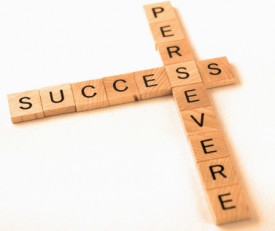 How to teach persistence
How to teach persistence
One of our main goals as educators should be teaching students persistence in the classroom, since it's an important part of setting up learners to succeed. Students who have mastered persistence are able to work through challenges, deal constructively with failures and adversity, and achieve the goals they have set for themselves.
It’s a lot like running a marathon. The runners who make it to the finish line are the ones who persist in showing up for practices and trainings, learn to anticipate slumps and pace themselves, engage in positive self-talk during tough times, take steps to effectively prevent and treat injuries, and adjust expectations to fit reality – even if “finishing” means having to crawl the last mile.
Like a runner who has not trained to run longer distances, learners can’t persist in their learning if they haven’t developed the stamina they need to keep going when things get tough. Teaching persistence depends on first developing student stamina as a way of conditioning learners to handle sustained effort.
To help learners build stamina and persistence, it’s important to create the right learning environment:
Help Learners Develop a Growth Mindset
Learners need to know that they have the ability to grow and change, and that effort is the key. Praise them when they focus their efforts toward specific, clearly defined goals. When you say things like, “Those extra 10 minutes of reading each day are paying off – you are decoding unfamiliar words much more easily now,” you help learners make the connection between effort and achievement. The goal is for learners to become intrinsically motivated to engage in effortful learning now and in the future.
Push a Little Bit – and Know When Enough is Enough
Sometimes learners just need a little bit of encouragement to get past a hurdle. A few supportive words, like, “Think of how good you will feel when you finish those last two addition problems and you know you did the whole worksheet all by yourself!” can make all the difference. On the other hand, a learner may need to know that it’s okay to take a break and come back to a particular task when he’s feeling less frustrated. In that case, it’s important that the learner really does come back and complete the work to get the experience that he truly can “do more” when he persists.
Model Persistence
Most learners love to hear personal stories from their teachers. Telling your learners about your weekend plumbing project that didn’t go as planned – and how you got through it and completed it – is a great way to help learners see that everyone feels like giving up sometimes. It also models for them how to overcome those feelings and reach a goal – without coming off as preachy.
Teach Positive Self-Talk
Some learners need a lot of help knowing what to say to themselves to stay motivated. If a learner’s typical internal dialogue consists of statements like, “This is too hard,” or “I don’t know how to do this,” it may come as a revelation to discover that there are other options. Giving learners specific wording, like, “I know I can do this if I keep at it,” or, “If I’m really stuck I can ask a friend or my teacher for help,” can begin to change the way they think and act when faced with a challenge.
Expect More
Let learners know that you have high expectations and that you have confidence that each and every one of them can meet those expectations. Be sure they have access to the tools they need to be successful, and that they know how to use them.
Make the Most of Technology
Online tools like the Fast ForWord program can help learners make the connection between effort and achievement. The Fast ForWord program gradually builds learner stamina for enduring increasing degrees of cognitive load. The exercises develop reading and language skills at the same time as they boost memory, attention, processing, and sequencing ability. It gives learners immediate feedback on their performance and automatically adjusts the difficulty level for just the right degree of challenge. Fun reward animations help learners see when they have achieved a goal to help them stay motivated.
Call Out the Brain
It’s never too early – or too late – to teach your students about how the brain learns. Introduce the concept of brain plasticity– the idea that the brain changes in response to how it’s used – as a way of reinforcing the idea that learning is achieved through focused, sustained effort. Help them understand that every brain is capable of making dramatic changes and leaps in learning.
Repeat, Repeat, Repeat
Students learn persistence in the same way that they learn sight words or multiplication tables – through repetition. Strategies like modeling persistence, connecting effort to achievement, and pushing students to do a little more than they think they can aren’t a one-time deal. But when repeated over time, the cumulative effect will likely be increased stamina, improved persistence, and intrinsic motivation for ever greater learning.
For Further Reading:
True Grit: 10 tips for promoting strength, resilience, and perseverance among your students.
Promoting Grit, Tenacity, and Perseverance: Critical Factors for Success in the 21st Century
Related reading:
Deliberate Practice: How to Develop Expertise
The Curious Mind: Interest, Drive, and the Road to Academic Success

